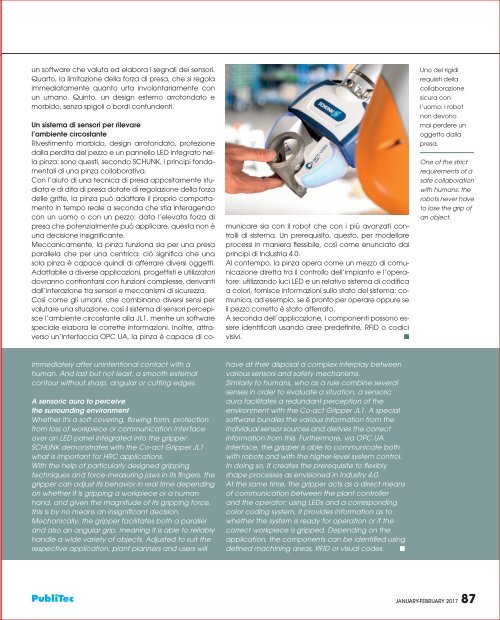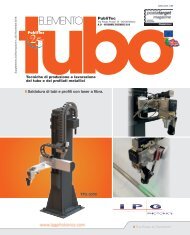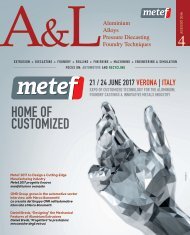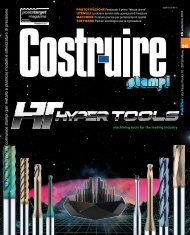sfogliabile_ASS_n118_GEN_FEB_2017
You also want an ePaper? Increase the reach of your titles
YUMPU automatically turns print PDFs into web optimized ePapers that Google loves.
84-87 4<br />
un software che valuta ed elabora i segnali dei sensori.<br />
Quarto, la limitazione della forza di presa, che si regola<br />
immediatamente quanto urta involontariamente con<br />
un umano. Quinto, un design esterno arrotondato e<br />
morbido, senza spigoli o bordi contundenti.<br />
Un sistema di sensori per rilevare<br />
l’ambiente circostante<br />
Rivestimento morbido, design arrotondato, protezione<br />
dalla perdita del pezzo e un pannello LED integrato nella<br />
pinza: sono questi, secondo SCHUNK, i principi fondamentali<br />
di una pinza collaborativa.<br />
Con l’aiuto di una tecnica di presa appositamente studiata<br />
e di dita di presa dotate di regolazione della forza<br />
delle griffe, la pinza può adattare il proprio comportamento<br />
in tempo reale a seconda che stia interagendo<br />
con un uomo o con un pezzo: data l’elevata forza di<br />
presa che potenzialmente può applicare, questa non è<br />
una decisione insignificante.<br />
Meccanicamente, la pinza funziona sia per una presa<br />
parallela che per una centrica: ciò significa che una<br />
sola pinza è capace quindi di afferrare diversi oggetti.<br />
Adattabile a diverse applicazioni, progettisti e utilizzatori<br />
dovranno confrontarsi con funzioni complesse, derivanti<br />
dall’interazione tra sensori e meccanismi di sicurezza.<br />
Così come gli umani, che combinano diversi sensi per<br />
valutare una situazione, così il sistema di sensori percepisce<br />
l’ambiente circostante alla JL1, mentre un software<br />
speciale elabora le corrette informazioni. Inoltre, attraverso<br />
un’interfaccia OPC UA, la pinza è capace di comunicare<br />
sia con il robot che con i più avanzati controlli<br />
di sistema. Un prerequisito, questo, per modellare<br />
processi in maniera flessibile, così come enunciato dai<br />
principi di Industria 4.0.<br />
Al contempo, la pinza opera come un mezzo di comunicazione<br />
diretta tra il controllo dell’impianto e l’operatore:<br />
utilizzando luci LED e un relativo sistema di codifica<br />
a colori, fornisce informazioni sullo stato del sistema: comunica,<br />
ad esempio, se è pronto per operare oppure se<br />
il pezzo corretto è stato afferrato.<br />
A seconda dell’applicazione, i componenti possono essere<br />
identificati usando aree predefinite, RFID o codici<br />
visivi.<br />
n<br />
Uno dei rigidi<br />
requisiti della<br />
collaborazione<br />
sicura con<br />
l’uomo: i robot<br />
non devono<br />
mai perdere un<br />
oggetto dalla<br />
presa.<br />
One of the strict<br />
requirements of a<br />
safe collaboration<br />
with humans: the<br />
robots never have<br />
to lose the grip of<br />
an object.<br />
immediately after unintentional contact with a<br />
human. And last but not least, a smooth external<br />
contour without sharp, angular or cutting edges.<br />
A sensoric aura to perceive<br />
the surrounding environment<br />
Whether it's a soft covering, flowing form, protection<br />
from loss of workpiece or communication interface<br />
over an LED panel integrated into the gripper:<br />
SCHUNK demonstrates with the Co-act Gripper JL1<br />
what is important for HRC applications.<br />
With the help of particularly designed gripping<br />
techniques and force-measuring jaws in its fingers, the<br />
gripper can adjust its behavior in real time depending<br />
on whether it is gripping a workpiece or a human<br />
hand, and given the magnitude of its gripping force,<br />
this is by no means an insignificant decision.<br />
Mechanically, the gripper facilitates both a parallel<br />
and also an angular grip, meaning it is able to reliably<br />
handle a wide variety of objects. Adjusted to suit the<br />
respective application, plant planners and users will<br />
have at their disposal a complex interplay between<br />
various sensors and safety mechanisms.<br />
Similarly to humans, who as a rule combine several<br />
senses in order to evaluate a situation, a sensoric<br />
aura facilitates a redundant perception of the<br />
environment with the Co-act Gripper JL1. A special<br />
software bundles the various information from the<br />
individual sensor sources and derives the correct<br />
information from this. Furthermore, via OPC UA<br />
interface, the gripper is able to communicate both<br />
with robots and with the higher-level system control.<br />
In doing so, it creates the prerequisite to flexibly<br />
shape processes as envisioned in Industry 4.0.<br />
At the same time, the gripper acts as a direct means<br />
of communication between the plant controller<br />
and the operator: using LEDs and a corresponding<br />
color coding system, it provides information as to<br />
whether the system is ready for operation or if the<br />
correct workpiece is gripped. Depending on the<br />
application, the components can be identified using<br />
defined machining areas, RFID or visual codes. n<br />
PubliTec<br />
JANUARY-<strong>FEB</strong>RUARY <strong>2017</strong> 87





